
Bipolar transistor biasing
Encyclopedia
Bipolar transistor amplifiers must be properly biased
to operate correctly. In circuits made with individual devices (discrete circuits), biasing networks consisting of resistor
s are commonly employed. Much more elaborate biasing arrangements are used in integrated circuits, for example, bandgap voltage reference
s and current mirror
s.
The operating point of a device, also known as bias point, quiescent point, or Q-point, is the point on the output characteristics that shows the DC
collector–emitter voltage (Vce) and the collector current (Ic) with no input signal applied. The term is normally used in connection with devices such as transistors.
Q-point should be stable. In particular, it should be insensitive to variations in transistor parameters (for example, should not shift if transistor is replaced by another of the same type), variations in temperature, variations in power supply voltage and so forth.
The circuit must be practical: easily implemented and cost-effective.
. There are several approaches to mitigate bipolar transistor thermal runaway. For example,
The circuits below primarily demonstrate the use of negative feedback to prevent thermal runaway.
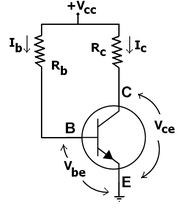 This form of biasing is also called base bias. In the example image on the right, the single power source (for example, a battery) is used for both collector and base of a transistor, although separate batteries can also be used.
This form of biasing is also called base bias. In the example image on the right, the single power source (for example, a battery) is used for both collector and base of a transistor, although separate batteries can also be used.
In the given circuit,
Therefore,
For a given transistor, Vbe does not vary significantly during use. As Vcc is of fixed value, on selection of RB, the base current IB is fixed. Therefore this type is called fixed bias type of circuit.
Also for given circuit,
Therefore,
The common-emitter current gain of a transistor is an important parameter in circuit design, and is specified on the data sheet for a particular transistor. It is denoted as β on this page.
Because
we can obtain IC as well. In this manner, operating point given as (Vce,IC) can be set for given transistor.
Merits:
Demerits:
Usage:
Due to the above inherent drawbacks, fixed bias is rarely used in linear circuits (i.e., those circuits which use the transistor as a current source). Instead, it is often used in circuits where transistor is used as a switch. However, one application of fixed bias is to achieve crude automatic gain control
in the transistor by feeding the base resistor from a DC signal derived from the AC output of a later stage.
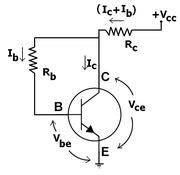 This configuration employs negative feedback
This configuration employs negative feedback
to prevent thermal runaway
and stabilize the operating point. In this form of biasing, the base resistor is connected to the collector instead of connecting it to the DC source
is connected to the collector instead of connecting it to the DC source  . So any thermal runaway will induce a voltage drop across the
. So any thermal runaway will induce a voltage drop across the  resistor that will throttle the transistor's base current.
resistor that will throttle the transistor's base current.
From Kirchhoff's voltage law, the voltage across the base resistor
across the base resistor  is
is

By the Ebers–Moll model, , and so
, and so

From Ohm's law
, the base current , and so
, and so

Hence, the base current is
is

If is held constant and temperature increases, then the collector current
is held constant and temperature increases, then the collector current  increases. However, a larger
increases. However, a larger  causes the voltage drop across resistor
causes the voltage drop across resistor  to increase, which in turn reduces the voltage
to increase, which in turn reduces the voltage  across the base resistor
across the base resistor  . A lower base-resistor voltage drop reduces the base current
. A lower base-resistor voltage drop reduces the base current  , which results in less collector current
, which results in less collector current  . Because an increase in collector current with temperature is opposed, the operating point is kept stable.
. Because an increase in collector current with temperature is opposed, the operating point is kept stable.
Merits:
Demerits:
which is the case when
Usage:
The feedback also decreases the input impedance of the amplifier as seen from the base, which can be advantageous.
Due to the gain reduction from feedback, this biasing form is used only when the trade-off for stability is warranted.
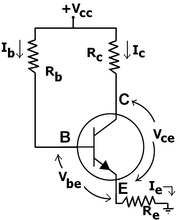 The fixed bias circuit is modified by attaching an external resistor to the emitter. This resistor introduces negative feedback
The fixed bias circuit is modified by attaching an external resistor to the emitter. This resistor introduces negative feedback
that stabilizes the Q-point. From Kirchhoff's voltage law, the voltage across the base resistor is
VRb = VCC - IeRe - Vbe.
From Ohm's law
, the base current is
Ib = VRb / Rb.
The way feedback controls the bias point is as follows. If Vbe is held constant and temperature increases, emitter current increases. However, a larger Ie increases the emitter voltage Ve = IeRe, which in turn reduces the voltage VRb across the base resistor. A lower base-resistor voltage drop reduces the base current, which results in less collector current because Ic = ß IB. Collector current and emitter current are related by Ic = α Ie with α ≈ 1, so increase in emitter current with temperature is opposed, and operating point is kept stable.
Similarly, if the transistor is replaced by another, there may be a change in IC (corresponding to change in β-value, for example). By similar process as above, the change is negated and operating point kept stable.
For the given circuit,
IB = (VCC - Vbe)/(RB + (β+1)RE).
Merits:
The circuit has the tendency to stabilize operating point against changes in temperature and β-value.
Demerits:
which is approximately the case if
Usage:
The feedback also increases the input impedance of the amplifier when seen from the base, which can be advantageous. Due to the above disadvantages, this type of biasing circuit is used only with careful consideration of the trade-offs involved.
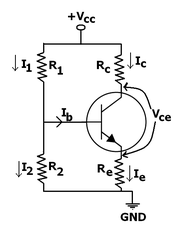
The voltage divider is formed using external resistors R1 and R2. The voltage across R2 forward biases the emitter junction. By proper selection of resistors R1 and R2, the operating point of the transistor can be made independent of β. In this circuit, the voltage divider holds the base voltage fixed independent of base current provided the divider current is large compared to the base current. However, even with a fixed base voltage, collector current varies with temperature (for example) so an emitter resistor is added to stabilize the Q-point, similar to the above circuits with emitter resistor.
In this circuit the base voltage is given by:
 voltage across
voltage across 

 provided
provided  .
.
Also
For the given circuit,
Biasing (electronics)
Biasing in electronics is the method of establishing predetermined voltages and/or currents at various points of an electronic circuit to set an appropriate operating point...
to operate correctly. In circuits made with individual devices (discrete circuits), biasing networks consisting of resistor
Resistor
A linear resistor is a linear, passive two-terminal electrical component that implements electrical resistance as a circuit element.The current through a resistor is in direct proportion to the voltage across the resistor's terminals. Thus, the ratio of the voltage applied across a resistor's...
s are commonly employed. Much more elaborate biasing arrangements are used in integrated circuits, for example, bandgap voltage reference
Bandgap voltage reference
A bandgap voltage reference is a temperature independent voltage reference circuit widely used in integrated circuits, usually with an output voltage around 1.25 V, close to the theoretical 1.22 eV bandgap of silicon at 0 K. This circuit concept was first published by David Hilbiber in 1964...
s and current mirror
Current mirror
A current mirror is a circuit designed to copy a current through one active device by controlling the current in another active device of a circuit, keeping the output current constant regardless of loading. The current being 'copied' can be, and sometimes is, a varying signal current...
s.
The operating point of a device, also known as bias point, quiescent point, or Q-point, is the point on the output characteristics that shows the DC
Direct current
Direct current is the unidirectional flow of electric charge. Direct current is produced by such sources as batteries, thermocouples, solar cells, and commutator-type electric machines of the dynamo type. Direct current may flow in a conductor such as a wire, but can also flow through...
collector–emitter voltage (Vce) and the collector current (Ic) with no input signal applied. The term is normally used in connection with devices such as transistors.
Signal requirements for Class A amplifiers
For analog operation of a Class A amplifier, the Q-point is placed so the transistor stays in active mode (does not shift to operation in the saturation region or cut-off region) when input is applied. For digital operation, the Q-point is placed so the transistor does the contrary - switches from "on" to "off" state. Often, Q-point is established near the center of active region of transistor characteristic to allow similar signal swings in positive and negative directions.Q-point should be stable. In particular, it should be insensitive to variations in transistor parameters (for example, should not shift if transistor is replaced by another of the same type), variations in temperature, variations in power supply voltage and so forth.
The circuit must be practical: easily implemented and cost-effective.
Thermal considerations
At constant current, the voltage across the emitter–base junction VBE of a bipolar transistor decreases 2 mV (silicon) and 1.8mV (germanium) for each 1 °C rise in temperature (reference being 25 °C). By the Ebers–Moll model, if the base–emitter voltage VBE is held constant and the temperature rises, the current through the base–emitter diode IB will increase, and thus the collector current IC will also increase. Depending on the bias point, the power dissipated in the transistor may also increase, which will further increase its temperature and exacerbate the problem. This deleterious positive feedback results in thermal runawayThermal runaway
Thermal runaway refers to a situation where an increase in temperature changes the conditions in a way that causes a further increase in temperature, often leading to a destructive result...
. There are several approaches to mitigate bipolar transistor thermal runaway. For example,
- Negative feedbackNegative feedbackNegative feedback occurs when the output of a system acts to oppose changes to the input of the system, with the result that the changes are attenuated. If the overall feedback of the system is negative, then the system will tend to be stable.- Overview :...
can be built into the biasing circuit so that increased collector current leads to decreased base current. Hence, the increasing collector current throttles its source. - Heat sinkHeat sinkA heat sink is a term for a component or assembly that transfers heat generated within a solid material to a fluid medium, such as air or a liquid. Examples of heat sinks are the heat exchangers used in refrigeration and air conditioning systems and the radiator in a car...
s can be used that carry away extra heat and prevent the base–emitter temperature from rising. - The transistor can be biased so that its collector is normally less than half of the power supply voltage, which implies that collector–emitter power dissipation is at its maximum value. Runaway is then impossible because increasing collector current leads to a decrease in dissipated power; this notion is known as the half-voltage principle.
The circuits below primarily demonstrate the use of negative feedback to prevent thermal runaway.
Types of bias circuit for Class A amplifiers
The following discussion treats five common biasing circuits used with Class A bipolar transistor amplifiers:- Fixed bias
- Collector-to-base bias
- Fixed bias with emitter resistor
- Voltage divider bias
- Emitter bias
Fixed bias (base bias)

In the given circuit,
- Vcc = IBRB + Vbe
Therefore,
- IB = (Vcc - Vbe)/RB
For a given transistor, Vbe does not vary significantly during use. As Vcc is of fixed value, on selection of RB, the base current IB is fixed. Therefore this type is called fixed bias type of circuit.
Also for given circuit,
- Vcc = ICRC + Vce
Therefore,
- Vce = Vcc - ICRC
The common-emitter current gain of a transistor is an important parameter in circuit design, and is specified on the data sheet for a particular transistor. It is denoted as β on this page.
Because
- IC = βIB
we can obtain IC as well. In this manner, operating point given as (Vce,IC) can be set for given transistor.
Merits:
- It is simple to shift the operating point anywhere in the active region by merely changing the base resistor (RB).
- A very small number of components are required.
Demerits:
- The collector current does not remain constant with variation in temperature or power supply voltage. Therefore the operating point is unstable.
- Changes in Vbe will change IB and thus cause RE to change. This in turn will alter the gain of the stage.
- When the transistor is replaced with another one, considerable change in the value of β can be expected. Due to this change the operating point will shift.
- For small-signal transistors (e.g., not power transistors) with relatively high values of β (i.e., between 100 and 200), this configuration will be prone to thermal runawayThermal runawayThermal runaway refers to a situation where an increase in temperature changes the conditions in a way that causes a further increase in temperature, often leading to a destructive result...
. In particular, the stability factor, which is a measure of the change in collector current with changes in reverse saturation currentSaturation currentSaturation current is a term used in relation to semiconductor diodes. It is more fully, and accurately, named reverse saturation current and is "part of the reverse current in a diode caused by diffusion of minority carriers from the neutral regions to the depletion region...
, is approximately β+1. To ensure absolute stability of the amplifier, a stability factor of less than 25 is preferred, and so small-signal transistors have large stability factors.
Usage:
Due to the above inherent drawbacks, fixed bias is rarely used in linear circuits (i.e., those circuits which use the transistor as a current source). Instead, it is often used in circuits where transistor is used as a switch. However, one application of fixed bias is to achieve crude automatic gain control
Automatic gain control
Automatic gain control is an adaptive system found in many electronic devices. The average output signal level is fed back to adjust the gain to an appropriate level for a range of input signal levels...
in the transistor by feeding the base resistor from a DC signal derived from the AC output of a later stage.
Collector-to-base bias

Negative feedback
Negative feedback occurs when the output of a system acts to oppose changes to the input of the system, with the result that the changes are attenuated. If the overall feedback of the system is negative, then the system will tend to be stable.- Overview :...
to prevent thermal runaway
Thermal runaway
Thermal runaway refers to a situation where an increase in temperature changes the conditions in a way that causes a further increase in temperature, often leading to a destructive result...
and stabilize the operating point. In this form of biasing, the base resistor
 is connected to the collector instead of connecting it to the DC source
is connected to the collector instead of connecting it to the DC source  . So any thermal runaway will induce a voltage drop across the
. So any thermal runaway will induce a voltage drop across the  resistor that will throttle the transistor's base current.
resistor that will throttle the transistor's base current.From Kirchhoff's voltage law, the voltage
 across the base resistor
across the base resistor  is
is
By the Ebers–Moll model,
 , and so
, and so
From Ohm's law
Ohm's law
Ohm's law states that the current through a conductor between two points is directly proportional to the potential difference across the two points...
, the base current
 , and so
, and so
Hence, the base current
 is
is
If
 is held constant and temperature increases, then the collector current
is held constant and temperature increases, then the collector current  increases. However, a larger
increases. However, a larger  causes the voltage drop across resistor
causes the voltage drop across resistor  to increase, which in turn reduces the voltage
to increase, which in turn reduces the voltage  across the base resistor
across the base resistor  . A lower base-resistor voltage drop reduces the base current
. A lower base-resistor voltage drop reduces the base current  , which results in less collector current
, which results in less collector current  . Because an increase in collector current with temperature is opposed, the operating point is kept stable.
. Because an increase in collector current with temperature is opposed, the operating point is kept stable.Merits:
- Circuit stabilizes the operating point against variations in temperature and β (i.e. replacement of transistor)
Demerits:
- In this circuit, to keep
 independent of
independent of  , the following condition must be met:
, the following condition must be met:
which is the case when
- As
 -value is fixed (and generally unknown) for a given transistor, this relation can be satisfied either by keeping
-value is fixed (and generally unknown) for a given transistor, this relation can be satisfied either by keeping  fairly large or making
fairly large or making  very low.
very low. - If
 is large, a high
is large, a high  is necessary, which increases cost as well as precautions necessary while handling.
is necessary, which increases cost as well as precautions necessary while handling. - If
 is low, the reverse bias of the collector–base region is small, which limits the range of collector voltage swing that leaves the transistor in active mode.
is low, the reverse bias of the collector–base region is small, which limits the range of collector voltage swing that leaves the transistor in active mode.
- The resistor
 causes an ACAlternating currentIn alternating current the movement of electric charge periodically reverses direction. In direct current , the flow of electric charge is only in one direction....
causes an ACAlternating currentIn alternating current the movement of electric charge periodically reverses direction. In direct current , the flow of electric charge is only in one direction....
feedback, reducing the voltage gain of the amplifier. This undesirable effect is a trade-off for greater Q-point stability.
Usage:
The feedback also decreases the input impedance of the amplifier as seen from the base, which can be advantageous.
Due to the gain reduction from feedback, this biasing form is used only when the trade-off for stability is warranted.
Fixed bias with emitter resistor

Negative feedback
Negative feedback occurs when the output of a system acts to oppose changes to the input of the system, with the result that the changes are attenuated. If the overall feedback of the system is negative, then the system will tend to be stable.- Overview :...
that stabilizes the Q-point. From Kirchhoff's voltage law, the voltage across the base resistor is
VRb = VCC - IeRe - Vbe.
From Ohm's law
Ohm's law
Ohm's law states that the current through a conductor between two points is directly proportional to the potential difference across the two points...
, the base current is
Ib = VRb / Rb.
The way feedback controls the bias point is as follows. If Vbe is held constant and temperature increases, emitter current increases. However, a larger Ie increases the emitter voltage Ve = IeRe, which in turn reduces the voltage VRb across the base resistor. A lower base-resistor voltage drop reduces the base current, which results in less collector current because Ic = ß IB. Collector current and emitter current are related by Ic = α Ie with α ≈ 1, so increase in emitter current with temperature is opposed, and operating point is kept stable.
Similarly, if the transistor is replaced by another, there may be a change in IC (corresponding to change in β-value, for example). By similar process as above, the change is negated and operating point kept stable.
For the given circuit,
IB = (VCC - Vbe)/(RB + (β+1)RE).
Merits:
The circuit has the tendency to stabilize operating point against changes in temperature and β-value.
Demerits:
- In this circuit, to keep IC independent of β the following condition must be met:
which is approximately the case if
-
- ( β + 1 )RE >> RB.
- As β-value is fixed for a given transistor, this relation can be satisfied either by keeping RE very large, or making RB very low.
- If RE is of large value, high VCC is necessary. This increases cost as well as precautions necessary while handling.
- If RB is low, a separate low voltage supply should be used in the base circuit. Using two supplies of different voltages is impractical.
- In addition to the above, RE causes ac feedback which reduces the voltage gain of the amplifier.
Usage:
The feedback also increases the input impedance of the amplifier when seen from the base, which can be advantageous. Due to the above disadvantages, this type of biasing circuit is used only with careful consideration of the trade-offs involved.
Voltage divider biasing

The voltage divider is formed using external resistors R1 and R2. The voltage across R2 forward biases the emitter junction. By proper selection of resistors R1 and R2, the operating point of the transistor can be made independent of β. In this circuit, the voltage divider holds the base voltage fixed independent of base current provided the divider current is large compared to the base current. However, even with a fixed base voltage, collector current varies with temperature (for example) so an emitter resistor is added to stabilize the Q-point, similar to the above circuits with emitter resistor.
In this circuit the base voltage is given by:
 voltage across
voltage across 

 provided
provided  .
.Also

For the given circuit,
-

Merits:- Unlike above circuits, only one dc supply is necessary.
- Operating point is almost independent of β variation.
- Operating point stabilized against shift in temperature.
Demerits:- In this circuit, to keep IC independent of β the following condition must be met:
-

which is approximately the case if
where R1 || R2 denotes the equivalent resistanceSeries and parallel circuitsComponents of an electrical circuit or electronic circuit can be connected in many different ways. The two simplest of these are called series and parallel and occur very frequently. Components connected in series are connected along a single path, so the same current flows through all of the...
of R1 and R2 connected in parallel.
- As β-value is fixed for a given transistor, this relation can be satisfied either by keeping RE fairly large, or making R1||R2 very low.
- If RE is of large value, high VCC is necessary. This increases cost as well as precautions necessary while handling.
- If R1 || R2 is low, either R1 is low, or R2 is low, or both are low. A low R1 raises VB closer to VC, reducing the available swing in collector voltage, and limiting how large RC can be made without driving the transistor out of active mode. A low R2 lowers Vbe, reducing the allowed collector current. Lowering both resistor values draws more current from the power supply and lowers the input resistance of the amplifier as seen from the base.
- AC as well as DC feedback is caused by RE, which reduces the AC voltage gain of the amplifier. A method to avoid AC feedback while retaining DC feedback is discussed below.
Usage:
The circuit's stability and merits as above make it widely used for linear circuits.
Voltage divider with AC bypass capacitor
The standard voltage divider circuit discussed above faces a drawback - AC feedback caused by resistor RE reduces the gain. This can be avoided by placing a capacitor (CE) in parallel with RE, as shown in circuit diagram.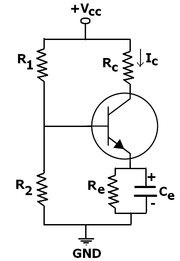
This capacitor is usually chosen to have a low enough reactance at the signal frequencies of interest such that RE is essentially shorted at AC, thus grounding the emitter. Feedback is therefore only present at DC to stabilize the operating point, in which case any AC advantages of feedback are lost.
Of course, this idea can be used to shunt only a portion of RE, thereby retaining some AC feedback.
Emitter bias
When a split supply (dual power supply) is available, this biasing circuit is the most effective, and provides zero bias voltage at the emitter or collector for load. The negative supply VEE is used to forward-bias the emitter junction through RE. The positive supply VCC is used to reverse-bias the collector junction. Only two resistors are necessary for the common collector stage and four resistors for the common emitter or common base stage.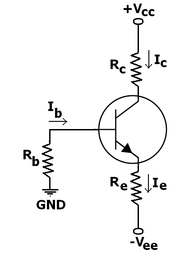
We know that,
VB - VE = Vbe
If RB is small enough, base voltage will be approximately zero. Therefore emitter current is,
IE = (VEE - Vbe)/RE
The operating point is independent of β if RE >> RB/β
Merit:
Good stability of operating point similar to voltage divider bias.
Demerit:
This type can only be used when a split (dual) power supply is available.
Signal requirements
Class B and AB amplifiers employ 2 active devices to cover the complete 360 deg of input signal flow. Each transistor is therefore biased to perform over approximately 180 deg of the input signal. Class B bias is when the collector current Ic with no signal is just conducting (about 1 % of maximum possible value). Class AB bias is when the collector current Ic is about 1/4 of maximum possible value.
The class AB push–pull output amplifier circuit below could be the basis for a moderate-power audio amplifier.

Q3 is a common emitterCommon emitterIn electronics, a common-emitter amplifier is one of three basic single-stage bipolar-junction-transistor amplifier topologies, typically used as a voltage amplifier...
stage that provides amplification of the signal and the DC bias current through D1 and D2 to generate a bias voltage for the output devices. The output pair are arranged in Class AB push–pull, also called a complementary pair. The diodeDiodeIn electronics, a diode is a type of two-terminal electronic component with a nonlinear current–voltage characteristic. A semiconductor diode, the most common type today, is a crystalline piece of semiconductor material connected to two electrical terminals...
s D1 and D2 provide a small amount of constant voltage bias for the output pair, just biasing them into the conducting state so that crossover distortion is minimized. That is, the diodes push the output stage into class-AB mode (assuming that the base-emitter drop of the output transistors is reduced by heat dissipation).
This design automatically stabilizes its operating point, since overall feedback internally operates from DC up through the audio range and beyond. The use of fixed diode bias requires the diodes to be both electrically and thermally matched to the output transistors. If the output transistors conduct too much, they can easily overheat and destroy themselves, as the full current from the power supply is not limited at this stage.
A common solution to help stabilize the output device operating point is to include some emitter resistors, typically an ohm or so. Calculating the values of the circuit's resistors and capacitors is done based on the components employed and the intended use of the amplifier.
See also
- Biasing (electronics)Biasing (electronics)Biasing in electronics is the method of establishing predetermined voltages and/or currents at various points of an electronic circuit to set an appropriate operating point...
- Small signal modelSmall signal modelSmall-signal modeling is a common analysis technique in electrical engineering which is used to approximate the behavior of nonlinear devices with linear equations...
- Bipolar junction transistorBipolar junction transistor|- align = "center"| || PNP|- align = "center"| || NPNA bipolar transistor is a three-terminal electronic device constructed of doped semiconductor material and may be used in amplifying or switching applications. Bipolar transistors are so named because their operation involves both electrons...
- MOSFETMOSFETThe metal–oxide–semiconductor field-effect transistor is a transistor used for amplifying or switching electronic signals. The basic principle of this kind of transistor was first patented by Julius Edgar Lilienfeld in 1925...
External links
- Bias – from Sci-Tech Encyclopedia
- Electrical Engineering Training Series: Types of bias
-





